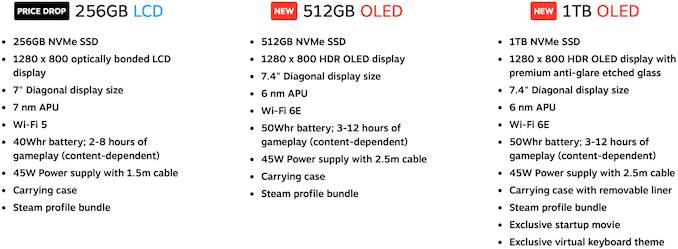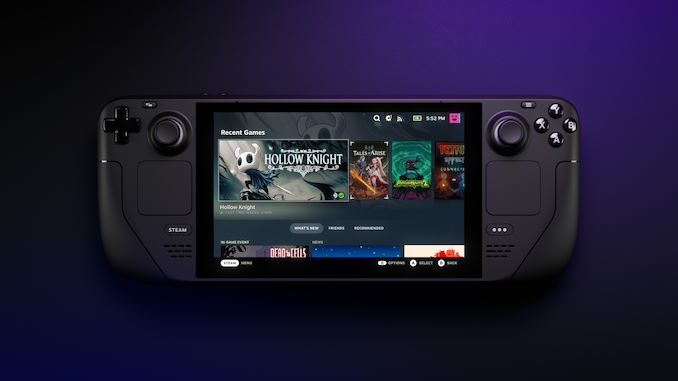Valve's Steam Deck OLED: Bigger Display, New SoC, Faster Memory, More Storage, Same Performance
by Anton Shilov on November 10, 2023 4:00 PM EST- Posted in
- Consoles
- Valve
- Steam Deck

In a quite unexpected turn of events, Valve has introduced a revamped version of its Steam Deck console that got a larger OLED display, a more efficient system-on-chip, a higher-performance memory subsystem, a 1 TB storage option, faster Wi-Fi 6E, and higher-capacity battery. While performance target of the portable gaming device remained the same, the new unit might just be faster than the original one due to faster memory. Meanwhile, the cheapest 256GB version of the console, which retained an LCD screen, now costs $399.
The main difference between the new Steam Deck OLED and the original Steam Deck is the larger 7.4-inch OLED display. The new screen retains a 1280x720 resolution, but it has a 600 nits typical brightness (a major improvement) and also supports HDR with a maximum zonal luminosity of 1000 nits, according to Tom's Hardware. The new monitor can also cover 101.8% of the DCI-P3 color gamut, up from 48.5% in case of the original Steam Deck, our colleagues found out. Despite the larger display, the console retained dimensions of the original one, but got 29 grams lighter since OLEDs do not need a backlighting module and a display driver with all the appropriate circuitry.
Another major change from the original one is that Steam Deck OLED uses AMD's new semi-custom SoC with four Zen 2 x86 cores and an RDNA 2-based GPU with 512 stream processors that is now made on TSMC's N6 process technology. Usage of N6 made the SoC a little cheaper to produce and allowed to retain the original 4W – 15W power envelope without the need to vary GPU clock from 1.0 GHz to 1.60 GHz, which may have a mild positive effect on performance in certain games.
An interesting detail about the new unit is that it uses a 16 GB LPDDR5-6400 memory subsystem with a 102.4 GB/s of peak bandwidth, up from 88 GB/s bandwidth in case of the original one. We can only wonder whether a 16% memory bandwidth boost will significantly affect gaming performance, but we feel it could bring a boost in certain bandwidth-hungry scenarios. Alternatively, faster memory may be just a bit more power efficient.
Speaking of power, it should be noted that the Steam Deck OLED also comes with a 50 Wh battery, up from a 40 Wh battery in the original one, so expect the new one to have a longer battery life. Meanwhile, the new console comes with a longer 2.5-meter power cord.
Yet another notable improvement of the Steam Deck OLED is 1 TB storage subsystem (and the M.2-2230 drive can still be replaced with something different) on the range-topping model. Meanwhile, to download games faster, Steam Deck OLED comes with a Wi-Fi 6E adapter, up from Wi-Fi 5 on the original model.
Valve launches its Steam Deck OLED in time for the holiday shopping system and in addition to make the product more attractive overall, it also makes the platform more accessible. The older 64 GB eMMC model with an LCD screen will be available for $349 while supplies last, whereas the 256 GB LCD version will cost $399 from now on (down from $529). The new Steam Deck OLED 512 GB is priced at $449, while the Steam Deck OLED 1 TB carries a $649 MSRP.
Source: Valve












49 Comments
View All Comments
dwillmore - Friday, November 10, 2023 - link
My understanding is "no" as it still used MIPI for the display and not eDP. But that's just what I heard.meacupla - Friday, November 10, 2023 - link
Yeah, it's probably the same screen used in Switch OLED.KimGitz - Friday, November 10, 2023 - link
Valve are still using a MIPI interface for their Display which means no VRR (Variable Refresh Rate) and no default landscape orientation.The Refresh Rate can be manually adjusted and locked at a fixed refresh rate upto 90Hz.
Hifihedgehog - Saturday, November 11, 2023 - link
Misleading on the default landscape orientation. SteamOS thanks to Proton, unlike Windows, properly handles all games on a rotated display. So there is literally no difference in running games on it versus a native landscape display.dwillmore - Friday, November 10, 2023 - link
I really want one of these, but I have absolutely no need for one. I tend to play keyboard/mouse games so I'm not even sure how that would work on a thing like this.But I do love HDR OLED displays.
Threska - Friday, November 10, 2023 - link
Gyro make difference.dwillmore - Saturday, November 11, 2023 - link
Sorry, what?quorm - Saturday, November 11, 2023 - link
https://en.m.wikipedia.org/wiki/GyrosHifihedgehog - Sunday, November 12, 2023 - link
https://disney.fandom.com/wiki/Gyro_GearlooseFWhitTrampoline - Saturday, November 11, 2023 - link
That new APU at 6nm is the PCIe Lanes to the M2 NVM/SSD still PCIe 3.0 or is that PCIe 4.0 Instead? And even though the Steam Deck has no USB4/40Gbs port it can be used with an eGPU if one gets an M.2 to OCuLink adapter but the OS will have to be run from A USB stick instead.But the bandwidth for OCuLink on a PCIe 3.0/X4(M.2) interface is limited to around 40Gbs while if that same x4 PCIe interface was PCIe 4.0 then that would provide about 64Gbs of bandwidth. But really the folks Online are not focusing enough attention on the SSD interface specifications for the Steam Deck OLED edition.
So the Original Steam Deck was tested on YouTube with an eGPU(Portable Radeon 7600M XT GPD eGPU that supports OCuLink) m.2 to OCuLink adapter and had really nice performance there even with the total bandwidth limited to PCIe 3.0/X4.